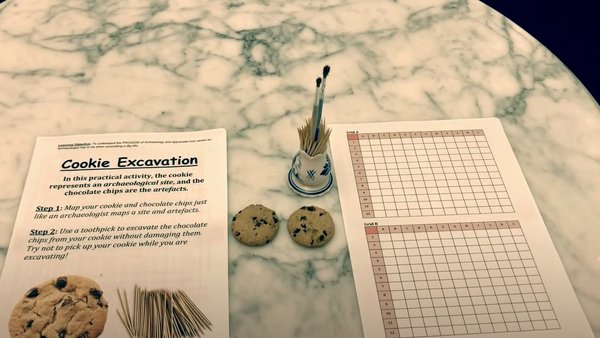The activity has been completed by four primary school classes who took part in FUTURES Discover and Discuss sessions, which gave them the chance to meet Francesca Fulminante via Zoom to talk about the activity and ask questions. Francesca heard how they had gained an insight into the complexities of how archaeological digs work; they learned to be careful and to dig closely around the chips to extract them. In addition, when they dug the first layer of chips, they often found some more chips underneath. This also happens in a real excavation: you dig one layer and there is another one, two or three underneath and you have to plan again and so on. They also had to deal with crumbs and dust like in a real sunny Mediterranean excavation.
The children wanted to know more about what it’s like to be involved in a real excavation. Francesca reflected that the children asked a lot of interesting questions: “which tools are used? what the weather is like? How we can date things? How valuable are things discovered? How long does it take to become an archaeologist? What is the rarest thing I excavated? Which is my favourite one? My favourite site? Do I have to travel a lot? Which was the first artifact I excavated? Which I had to admit I have forgotten …… And which is the biggest thing? To which I replied that I was in a team that re-discovered the forgotten Forum of Veii, a full Roman square market, at least at the level of foundations (all 11 marble columns had been already robbed in the past and are today reused in Palace Wedekind in Place Colonna in Roma), not too bad as a young Archaeologist in Rome”.
Francesca also showed them where she learned to be an archaeologist, in the Forum Romanum, in a little “garden” between the Arch of Titus and the Vesta Temple, in front of the Basilica of Massentius; again not a bad place for a novice. The more exciting thing of that excavation was that the Forum was a place of intense activity for many centuries since the Bronze Age to the present (2300 BC to 1900 AD) so is very full of remains. You can find the foundations of a storage building of the late Domitian or early Trajan time (end of 1st- beginning of 2nd cen. AD), close to a republican drain (3rd-2nd cen. BC) and a kitchen of a house of the Archaic Period (600-500 BC). The archaeologist must disentangle it, like making a puzzle from hundreds of pieces.
Francesca also showed the children the main point of archaeology: learning how past people lived from the objects they used to learn life lessons from the past and behave better in the present and make better plans for the future. The children were very attentive and engaged and at the end when they were asked if they wanted to become archaeologists in the future they all raised their hands!
More info on FUTURES 2022-23: https://2022.futuresnight.co.uk/do-try-this-at-home/
More info on Francesca's project: https://2022.futuresnight.co.uk/do-try-this-at-home/cookie-archaeology/


